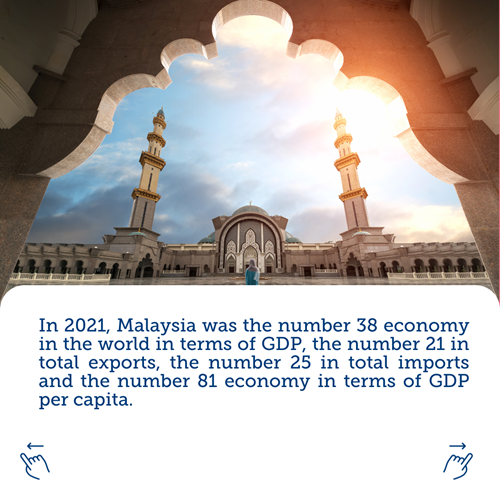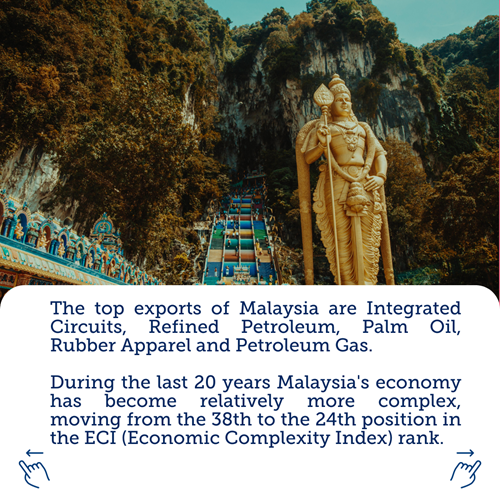Analysis and Studies - Country Analysis
Malaysia: a look at the market
December 4th 2023
Malaysia is a country situated in Southeast Asia. The federal constitutional monarchy consists of 13 states and three federal territories, separated by the South China Sea into 2 regions: Peninsular Malaysia and Borneo’s East Malaysia.
The country is multiethnic and multicultural, which has a significant effect on its politics.
After Independence, the gross domestic product (GDP) rise up at an average rate of 6.5% per year for almost 50 years. Malaysia’s country has traditionally been power by its natural resources, but it’s bolster into commerce, tourism and medical tourism. Moreover the country has a newly industrialised market economy, sorted 5th largest in Southeast Asia and 36th largest in the world.
Malaysia is also a founding member of the OIC (Organization of Islamic Cooperation), EAS (East Asia Summit) and ASEAN (Association of Southeast Asian Nations; furthermore it’s a member of the Non-Aligned Movement (NAM), the Commonwealth and the Asia Pacific Economic Cooperation (APEC).
A look at the market

It has the world's 36th largest economy in terms of nominal GDP and the 31st largest by PPP. In 2017, the large service sector contributed to 53.6% of total GDP, the industrial sector 37.6%, and the small agricultural sector close to 8.8%.
Malaysia has a depleted official unemployment rate of 3.9%. Its foreign exchange stockpiles are the world's 24th largest.
It has an elbow grease force of about 15 million, which is the world's 34th largest. Malaysia's large automotive industry valuates as the world's 22nd largest by production.
In addition, Malaysia is the world's 23rd largest exporter and 25thlargest importer. Nevertheless, economic inequalities have life between different ethnic groups.

The Chinese shake hands about one-quarter of the population, but account for 70 % of the country's market capitalization. Chinese corporates in Malaysia are part of the larger bamboo network, a network of multinational Chinese businesses in the Southeast Asian market split up common family and cultural ties.
International trade is streamlined by the shipping route in next-door Strait of Malacca, and manufacturing are the key sectors.
Malaysia is also an exporter of natural and agricultural resources, and petroleum is a leading export. Malaysia has once been the largest producer of tin, rubber and palm oil in the world. Manufacturing has an impact on the country's economy, although Malaysia's economic structure has been moving away from it.
Malaysia endures one of the world's largest producers of palm oil.
About latest trends, in September 2020, the top exports of Malaysia were Integrated Circuits (MYR21.3B), Palm Oil (MYR3.8B), Rubber Apparel (MYR3.78B), Refined Petroleum (MYR3.08B), and Semiconductor Devices (MYR2.74B).
On the other hand, in September 2020 the top imports of Malaysia were Integrated Circuits (MYR11.8B), Refined Petroleum (MYR3.74B), Telephones (MYR1.54B), Semiconductor Devices (MYR1.24B), and Gold (MYR1.06B).
Nevertheless, In September 2020, the hightening in Malaysia's year-by-year exports was explained first and foremost by pushing up in exports to China (43.4%), United States (25.5%), and Hong Kong (32.4%), and product exports deepening in Integrated Circuits (54.1%), Rubber Apparel (159%), and Palm Oil (37.7%).
In September 2020, the depreciation in Malaysia's year-by-year imports was spell out primarily by a fall in imports from Singapore (-15.5%), South Korea (-20.9%), and Thailand (-11.7%), and product imports step down in Refined Petroleum (39.8%), Crude Petroleum (-63.2%), and Gas Turbines (-72.3%).
Fonti:
https://oec.world/en
https://data.worldbank.org/
https://www.trademap.org/
